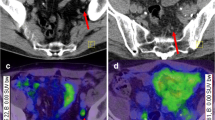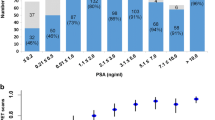Abstract
Background
68Ga-PSMA Positron Emission Tomography/Computerized Tomography (PET/CT) has shown promising results for the detection of recurrent prostate cancer (RPCa). However, the diagnostic value of this method is yet to be validated. The aim of this study was to determine the influence of clinical and biochemical variables on the detection rate of 68Ga-PSMA PET/CT in patients with RPCa.
Methods
This is a prospective study of 121 patients who underwent 68Ga-PSMA-PET/CT and conventional imaging (CI) for RPCa. Detection rates were analyzed and correlated with various clinical and biochemical variables such as Gleason score GS), androgen deprivation therapy (ADT), trigger PSA (tPSA), PSA doubling-time (PSAdt) and PSA velocity (PSAv).
Results
68Ga-PSMA-PET/CT showed at least one focus of pathological 68Ga-PSMA uptake in 92/121 (76%) of patients. Nodal metastases (in 47% of patients) were the most common site of recurrent disease followed by bones (36%) and prostate (32%). Out of 121 patients, 57 (47%) had only positive findings on PSMA scan verified by biopsy or follow-up. The majority of these lesion were located in the lymph nodes (31/57, 54,5%), which were below the detection limit of CT. Univariate analysis showed higher detection rate of PET/CT with increasing tPSA, PSAv and short PSAdt. Best cutoff for tPSA, PSAv and PSAdt was 0.5 ng/ml, 2.25 ng/ml/year and 8.65 months, respectively. The detection rate of PSMA-PET/CT was higher in patients with high grade tumors (GS > 7, 23.7% vs 76.3%) and in patients who were on ADT during of PSMA scan (76.3% vs 96%). In multiple logistic regression analysis, PSAdt and concurrent ADT were identified as predictors of positive 68Ga-PSMA-PET/CT.
Conclusion
68Ga-PSMA-PET/CT is useful for re-staging patients with RPCa and has improved performance compared with CI for disease detection. Detection rates are improved in patients on ADT and with short PSAdt.



Similar content being viewed by others
References
Eder M, Neels O, Muller M et al (2014) Novel preclinical and radiopharmaceutical aspects of [68 Ga]Ga-PSMA-HBED-CC: a new PET tracer for imaging of prostate cancer. Pharmaceuticals (Basel) 7(7):779–796
Afshar-Oromieh A, Zechmann CM, Malcher A et al (2014) Comparison of PET imaging with a (68)Ga-labelled PSMA ligand and (18)F-choline-based PET/CT for the diagnosis of recurrent prostate cancer. Eur J Nucl Med Mol Imaging 41(1):11–20
Afshar-Oromieh A, Avtzi E, Giesel FL et al (2015) The diagnostic value of PET/CT imaging with the (68)Ga-labelled PSMA ligand HBED-CC in the diagnosis of recurrent prostate cancer. Eur J Nucl Med Mol Imaging 42(2):197–209
Minamimoto R, Hancock S, Schneider B et al (2016) Pilot comparison of (6)(8)Ga-RM2 PET and (6)(8)Ga-PSMA-11 PET in patients with biochemically recurrent prostate cancer. J Nucl Med 57(4):557–562
Eiber M, Herrmann K, Calais J et al (2018) Prostate cancer molecular imaging standardized evaluation (PROMISE): proposed miTNM classification for the interpretation of PSMA-ligand PET/CT. J Nucl Med 59(3):469–478
Eiber M, Maurer T, Souvatzoglou M et al (2015) Evaluation of hybrid (6)(8)Ga-PSMA ligand PET/CT in 248 patients with biochemical recurrence after radical prostatectomy. J Nucl Med 56(5):668–674
Afshar-Oromieh A, Malcher A, Eder M et al (2013) PET imaging with a [68Ga]gallium-labelled PSMA ligand for the diagnosis of prostate cancer: biodistribution in humans and first evaluation of tumour lesions. Eur J Nucl Med Mol Imaging 40(4):486–495
Ceci F, Uprimny C, Nilica B et al (2015) (68)Ga-PSMA PET/CT for restaging recurrent prostate cancer: which factors are associated with PET/CT detection rate? Eur J Nucl Med Mol Imaging 42(8):1284–1294
Wright GL, Haley C Jr, Beckett ML et al (1995) Expression of prostate-specific membrane antigen in normal, benign, and malignant prostate tissues. Urol Oncol 1(1):18–28
Marchal C, Redondo M, Padilla M et al (2004) Expression of prostate specific membrane antigen (PSMA) in prostatic adenocarcinoma and prostatic intraepithelial neoplasia. Histol Histopathol 19(3):715–718
Verburg FA, Pfister D, Drude NI, Mottaghy FM, Behrendt F (2017) PSA levels, PSA doubling time, Gleason score and prior therapy cannot predict measured uptake of [68Ga]PSMA-HBED-CC lesion uptake in recurrent/metastatic prostate cancer. Nuklearmedizin 56(6):225–232
Afshar-Oromieh A, Holland-Letz T, Giesel FL et al (2017) Diagnostic performance of 68Ga-PSMA-11 (HBED-CC) PET/CT in patients with recurrent prostate cancer: evaluation in 1007 patients. Eur J Nucl Med Mol Imaging 44(8):1258–1268
Good D, Schwarzenberger P, Eastham JA et al (1999) Cloning and characterization of the prostate-specific membrane antigen promoter. J Cell Biochem 74(3):395–405
Watt F, Martorana A, Brookes DE et al (2001) A tissue-specific enhancer of the prostate-specific membrane antigen gene, FOLH1. Genomics 73(3):243–254
Evans MJ, Smith-Jones PM, Wongvipat J et al (2011) Noninvasive measurement of androgen receptor signaling with a positron-emitting radiopharmaceutical that targets prostate-specific membrane antigen. Proc Natl Acad Sci USA 108(23):9578–9582
Hope TA, Truillet C, Ehman EC et al (2017) 68Ga-PSMA-11 PET imaging of response to androgen receptor inhibition: first human experience. J Nucl Med 58(1):81–84
Vallabhajosula S, Jhanwar Y, Tagawa S et al (2016) 99 m Tc-MIP-1404 planar and SPECT scan: imaging biomarker of androgen receptor (AR) signaling and prostate specific membrane antigen (PSMA) expression. J Nucl Med 57:1541
Schlenkhoff CD, Gaertner F, Essler M, Hauser S, Ahmadzadehfar H (2016) 68Ga-labeled anti-prostate-specific membrane antigen peptide as marker for androgen deprivation therapy response in prostate cancer. Clin Nucl Med 41(5):423–425
Denmeade SR, Sokoll LJ, Dalrymple S et al (2003) Dissociation between androgen responsiveness for malignant growth vs. expression of prostate specific differentiation markers PSA, hK2, and PSMA in human prostate cancer models. Prostate 54(4):249–257
Pyka T, Okamoto S, Dahlbender M et al (2016) Comparison of bone scintigraphy and 68Ga-PSMA PET for skeletal staging in prostate cancer. Eur J Nucl Med Mol Imaging 43(12):2114–2121
Author information
Authors and Affiliations
Contributions
ENA protocol/project development, data collection, data analysis, manuscript writing/editing. MT protocol/project development, data collection or management, data analysis, manuscript writing. FA data collection, manuscript editing. CYB data collection, manuscript editing. DEB data collection, manuscript editing. EK manuscript editing, statistics. HO data collection, manuscript editing. MC protocol/project development, data management, data analysis, manuscript writing.
Corresponding author
Ethics declarations
Conflict of interest
The authors declare that they have no conflict of interest.
Ethical approval
All procedures performed in studies involving human participants were in accordance with the ethical standards of the institutional and/or national research committee and with the 1964 Helsinki Declaration and its later amendments or comparable ethical standards.
Informed consent
Informed consent was obtained from all individual participants included in the study.
Rights and permissions
About this article
Cite this article
Akdemir, E.N., Tuncel, M., Akyol, F. et al. 68Ga-labelled PSMA ligand HBED-CC PET/CT imaging in patients with recurrent prostate cancer. World J Urol 37, 813–821 (2019). https://doi.org/10.1007/s00345-018-2460-y
Received:
Accepted:
Published:
Issue Date:
DOI: https://doi.org/10.1007/s00345-018-2460-y




